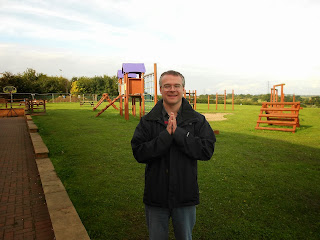As you may remember, my previous blog entry was about the magic of steam trains at Christmas. Something else that is often a wonder at Christmas is the atmosphere of a Christmas market in a medieval town square. For the past four Christmases now, I have had the pleasure of experiencing a Christmas atmosphere in a major European city, including in Amsterdam, Prague, Brussels and most recently, in Krakow, the former royal capital of Poland and home of the European Union's largest medieval town square. All four European Christmas breaks I have had have been beautiful, but here was something extra special about the Krakow Christmas experience. As well as simply just seeing Krakow at Christmas, I also felt that I got to sample a traditional Polish Christmas through a Christmas-themed tour of the city.
 |
| Christmas markets in Krakow's historic town square |
 |
| A brightly-coloured Polish-style nativity (szopka) |
Chwala na wysoksci (Hva-wah nah vee-sokosh-chee)
Chwala na wysoksci (Hva-wah nah vee-sokosh-chee)
A pokoj naziemi (Ah po-kooy nah zhe-mee)
Another multi-sensory experience I had after returning home from Poland was at a seminar on Asperger's Syndrome and mindfulness techniques I gave at the MAIN Project in Middlesbrough. In addition, I also experienced giving a seminar outside my comfort zone, which involved giving a presentation without the aid of Powerpoint slides! Sometimes, seminars deliver more for both the audience and the lecturer than was expected or prepared, and this one at MAIN was an example.
I didn't realise that I had had a full day allocated for me to give some training, so I had only prepared enough material for a morning session, which consisted of an introduction to mindfulness as well as how it may actually feel to be a person with Asperger's Syndrome. To imagine what it may be like to be a person with Asperger's Syndrome for someone not on the autistic spectrum can involve coming out of your comfort zone. However, something I realised when giving a seminar about coming out of your comfort zone to practice mindfulness was that I was stuck in the comfort zone of giving a seminar on something I was familiar with! What followed was another hour-and-a-half's session which I didn't realise I had, and didn't have anything prepared for! At one time, this would have been a panic situation for me, but by looking at it as an opportunity to practice mindfulness by coming out of my comfort zone and give a presentation not using a Powerpoint presentation and totally impromptu, added another dimension to the event.
 |
| Giving a seminar at MAIN in Middlesbrough |
From my last workshop of 2013, I felt I learned more than I actually taught. This year I have also learned that travelling can also deliver more than what was perhaps intended when initially setting out, often when you may least expect it. I would like to sign off by wishing all readers a very Merry Christmas and all the best for New Year..
During my visit to Poland, I also found time to visit Auschwitz-Birkenau, which continues to serve as a reminder of the horrors of the Nazi Holocaust as well as a warning to humanity. May the estimated 11 million victims of the Holocaust continue to rest in peace.

















